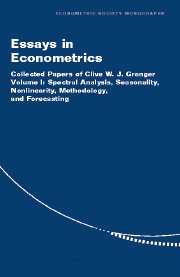Book contents
- Frontmatter
- Contents
- Acknowledgments
- List of Contributors
- Introduction
- 1 The ET Interview: Professor Clive Granger
- PART ONE SPECTRAL ANALYSIS
- PART TWO SEASONALITY
- 4 Seasonality: Causation, Interpretation and Implications
- 5 Is Seasonal Adjustment a Linear or Nonlinear Data-Filtering Process?
- PART THREE NONLINEARITY
- PART FOUR METHODOLOGY
- PART FIVE FORECASTING
- Index
5 - Is Seasonal Adjustment a Linear or Nonlinear Data-Filtering Process?
Published online by Cambridge University Press: 06 July 2010
- Frontmatter
- Contents
- Acknowledgments
- List of Contributors
- Introduction
- 1 The ET Interview: Professor Clive Granger
- PART ONE SPECTRAL ANALYSIS
- PART TWO SEASONALITY
- 4 Seasonality: Causation, Interpretation and Implications
- 5 Is Seasonal Adjustment a Linear or Nonlinear Data-Filtering Process?
- PART THREE NONLINEARITY
- PART FOUR METHODOLOGY
- PART FIVE FORECASTING
- Index
Summary
We investigate whether seasonal-adjustment procedures are, at least approximately, linear data transformations. This question was initially addressed by Young and is important with respect to many issues including estimation of regression models with seasonally adjusted data. We focus on the X-11 program and rely on simulation evidence, involving linear unobserved component autoregressive integrated moving average models. We define a set of properties for the adequacy of a linear approximation to a seasonal-adjustment filter. These properties are examined through statistical tests. Next, we study the effect of X-11 seasonal adjustment on regression statistics assessing the statistical significance of the relationship between economic variables. Several empirical results involving economic data are also reported.
Keywords: Aggregation; Cointegration; Nonlinearity; Regression; X-11 filter.
The question of whether seasonal-adjustment procedures are, at least approximately, linear data transformations is essential for several reasons. First, much of what is known about seasonal adjustment and estimation of regression models rests on the assumption that the process of removing seasonality can be adequately presented as a linear (twosided and symmetric) filter applied to the raw data. For instance, Sims (1974, 1993), Wallis (1974), Ghysels and Perron (1993), and Hansen and Sargent (1993), among others, examined the effect of filtering on estimating parameters or hypothesis testing. Naturally, the linearity of the filter is assumed because any nonlinear filter would make the problem analytically intractable. Second, the theoretical discussions regarding seasonal adjustment revolve around a linear representation.
- Type
- Chapter
- Information
- Essays in EconometricsCollected Papers of Clive W. J. Granger, pp. 147 - 174Publisher: Cambridge University PressPrint publication year: 2001



